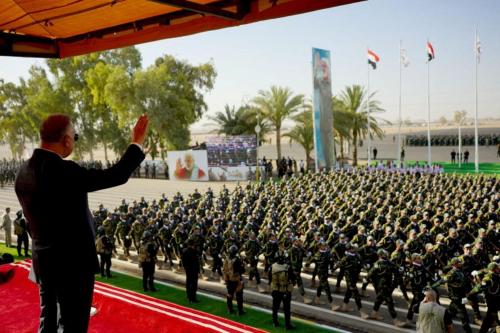As we reach the third anniversary of the start of the war, the confusion on the ground in Iraq seems to have spread to American generals’ public pronouncements. Last Monday, just days after saying that pacification efforts with the Iraqis were going “very, very well,” Gen. Peter Pace, chairman of the Joint Chiefs of Staff, told an audience that Iraq is “a place that is having some real difficulties right now” and that “everything is in place if they want to have a civil war.” Unfortunately, an examination of trends in Iraq backs up General Pace’s later, more sober comments.
The country’s economy continues to disappoint. Although it had a fairly quick recovery in 2003 and early 2004, when gross domestic product was restored to Saddam Hussein-era levels, violence and instability have prevented much further progress. And while subsidies for gasoline and some other goods, which have been costing the Iraqi government about $10 billion a year, or a third of gross domestic product, have been reduced, projections that the country’s economy will grow by 10 percent a year for the rest of the decade look increasingly suspect. Current growth sputters along at less than 5 percent despite sky-high prices for oil exports. Most utilities (except telephones and Internet services) are still performing below Baathist-era levels. Unemployment remains very high.
Politically, Iraqis have been stalemated in forming a new government since the impressive Dec. 15 elections, primarily over issues like ensuring fair distribution of Iraq’s oil revenue and devising ways to reintegrate lower-level former Baathists into society. This political inertia reinforces the widespread Sunni Arab sense of estrangement. And it contributes to remarkably high levels of Sunni Arab approval for violence against coalition troops (almost 90 percent) and even against their own government
Paradoxically, most of what good news there has been this winter is on the security front. American troop fatalities in Iraq have declined relative to last fall’s typical levels. Fatalities among Iraqi security forces have also gone down, as have car bombings. Unfortunately, civilian casualties have been as high as ever and, since the Feb. 22 bombing of the Samarra mosque, sectarian violence is worse than at any time since the invasion.
All that said, according to public opinion polls, more than 60 percent of Iraqis (though very few Sunni Arabs) remain bullish on the future. And Iraqi security forces continue to improve, with far higher percentages having reached the upper half of the four-tier readiness rating system. These statistics may point to the possibility of a troop drawdown strategy for the United States—but while a strategically passable outcome still seems within reach, it is increasingly hard to believe that there are the makings of a major success for American foreign policy in Iraq.
|
Categories |
Feb. 2004 |
Feb. 2005 |
Feb. 2006 |
|
U.S. Troop Fatalities |
21 |
56 |
54 |
|
Iraqi Security Force Fatalities |
65 |
103 |
158 |
|
Car Bombs (very rough) |
10 |
65 |
22 |
|
Iraqi Civilians Killed by War |
280 |
750 |
1,000 |
|
Estimated Number of Insurgents |
5,000 |
18,000 |
18,000 |
|
Estimated Number of Foreign Terrorists |
400 |
800 |
1,300 |
|
Average Number of Daily Attacks by Insurgents |
21 |
54 |
75 |
|
Top Baathists/Terrorists at Large |
35 |
31 |
26 |
|
Intelligence Tips Received from Iraqis |
300 |
400 |
4,000 |
|
U.S./Other Foreign Troops in Iraq (in thousands) |
115/24 |
155/25 |
133/20 |
|
Iraqi Security Personnel (in thousands) |
125 |
142 |
232 |
|
Iraqi Security Forces in Top Two Tiers of Readiness (in |
0 |
10 |
54 |
|
Oil Production (in millions of barrels per day; prewar: 2.5) |
2.3 |
2.1 |
1.8 |
|
Household Fuel Availability (percent of estimated need) |
88 |
84 |
55 |
|
Electricity Production (average megawatts; prewar estimate: |
4,100 |
3,600 |
3,700 |
|
Unemployment Rate (percent) |
38 |
33 |
32 |
|
Expected Sunni Arab Share of Iraq’s Future Oil Revenue |
20 |
20 |
5-10 |
|
Cumulative U.S. Aid Spent (in billions of dollars) |
0.1 |
5.6 |
13.4 |
|
Iraqis Optimistic About Their Future (percent) |
65 |
65 |
64 |
|
Iraqis Favoring Concrete Timeline for U.S. Withdrawal |
30 |
76 |
87 |
View the Op-Chart
(graphic by Amy Unikewicz)



Commentary
Op-edThe State of Iraq: An Update
March 19, 2006